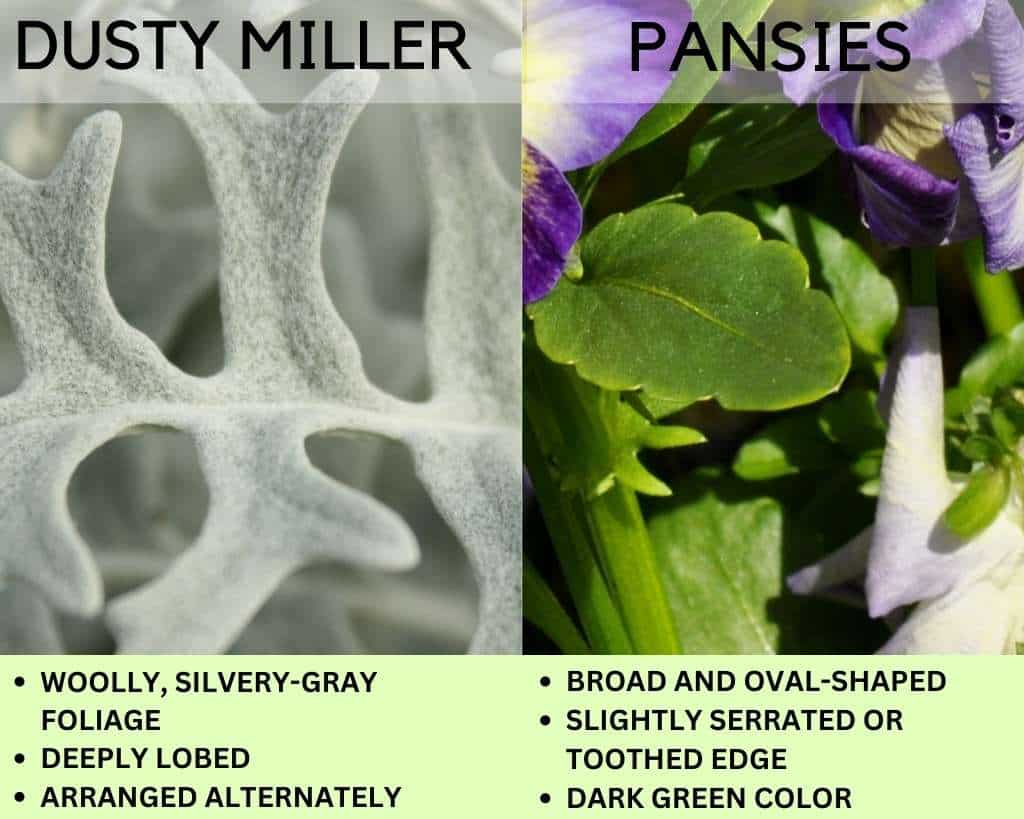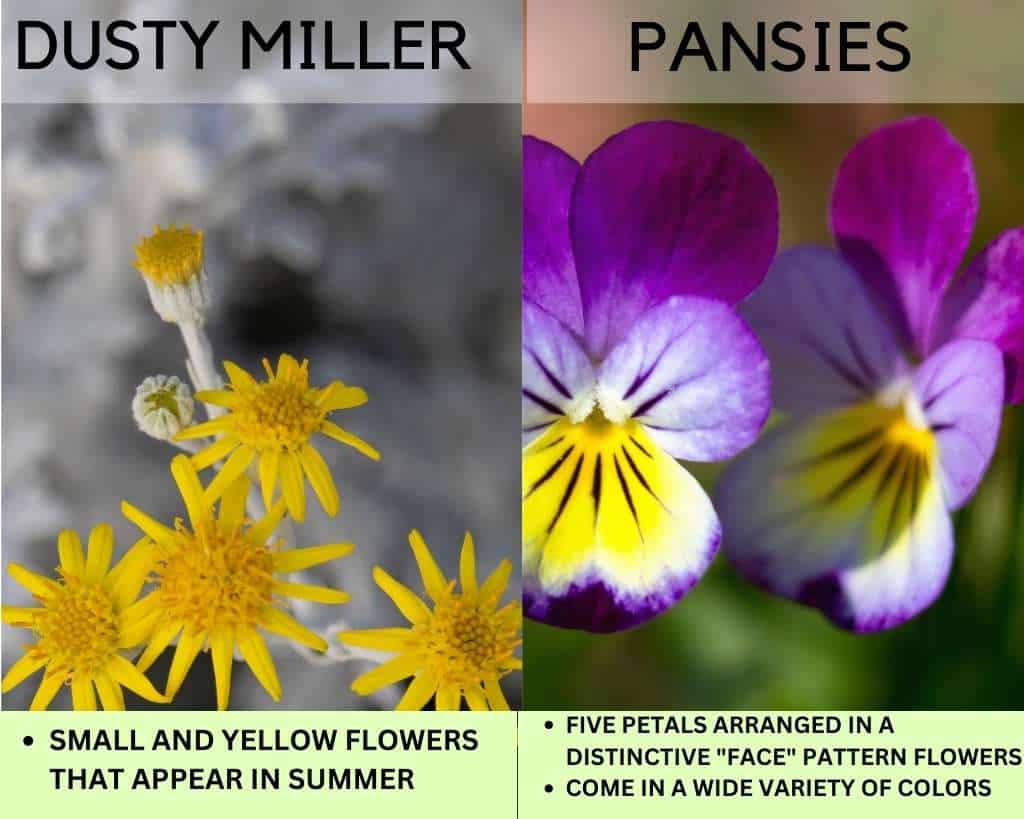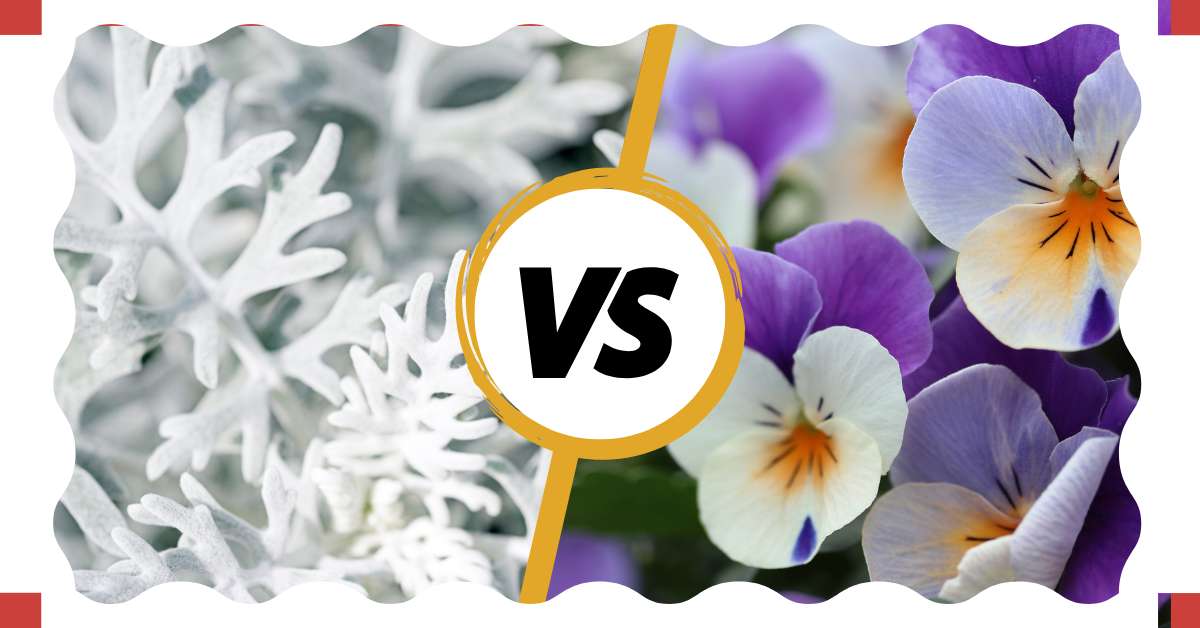Dusty miller and Pansies are popular ornamental plants mainly grown for their aesthetic value in landscaping. Dusty miller is valued for its attractive silvery foliage, while pansies are prized for their colorful flowers. Both plants are commonly used in gardens, landscapes, and container plantings to add visual interest and beauty.
In this article, we will discuss the differences, similarities and benefits of growing these plants in your garden.
| Dusty Miller | Pansies | |
| Name | Senecio cineraria | Viola tricolor var. hortensis |
| Lifespan | Annual/Perennial | Annual/Perennial |
| Zones | 8-11 | 6-10 |
| Height | 1-2 feet | 0.5-0.75 feet |
| Width | 1-2 feet | 0.75-1 feet |
| Sunlight | full sun to partial shade | full sun to partial shade |
| Soil | well-drained | well-drained |
| Origin | Mediterranean region | Europe and western Asia |
| Family | Asteraceae | Violaceae |
| Propagation | seeds, cuttings | seeds, division |
| Diseases | powdery mildew and rust | root rot, leaf spot, and powdery mildew |
| Pests | aphids and spider mites | aphids, thrips, and slugs |
Dusty Miller vs Pansies – Key Differences & Similarities

Plant Size
Dusty Miller (Senecio cineraria) generally grows at most 2 ft tall. However, some varieties, such as Ramparts, can grow as tall as 3 ft. Its spread is 1-2 feet, making it ideal for container gardening. It has a compact, bushy growth habit.
Pansies are shorter and more compact than dusty miller. They can grow up to 0.5-0.75 ft(15 to 23 cm) tall and has a spread of 0.75-1 ft (15 to 23 cm).
Stems

Dusty miller has a woody stem that can grow up to 2 feet tall. The stem is sturdy and robust, with a light green color and a slightly rough texture. The stem has tiny, delicate hairs that help repel insects and other pests. The stem of dusty miller is generally straight and upright, providing a sturdy support for the plant’s leaves and flowers.
In contrast, pansies have a soft, herbaceous stem that is not woody. The stem of pansies is typically green or reddish in color, and it is covered in fine, soft hairs. Pansies have short and branched stems, with leaves growing directly from them. The stem of pansies is less strong and sturdy than that of dusty miller, and it is more flexible and bendable.
Leaves – color, shape, size, and texture

The dusty miller leaves are silvery-gray in color, giving the plant a distinctive appearance. The leaves are deeply lobed, with a feather-like shape, and can grow up to 6 inches long. The texture of dusty miller leaves is fuzzy.
Pansy leaves come in various colors, including green, purple, and variegated combinations. The shape of pansy leaves is oval or heart-shaped, with a slightly serrated edge. In contrast to dusty miller, the leaves of pansies are smooth and grow up to 4 inches long.
In terms of size, dusty miller leaves are generally larger than pansies and have a more distinctive shape. The texture of dusty miller leaves is rougher than that of pansies, which have soft, smooth leaves.
Flowers

Dusty miller is primarily grown for its striking foliage, and while it does produce small yellow flowers in late summer, they are less showy or prominent than pansies. The dusty miller flowers are small, daisy-like, typically measuring around 1 inch in diameter. They have yellow petals and a dark center and grow in clusters on tall, slender stems.
Pansies, on the other hand, are grown exclusively for their attractive flowers. Its flowers come in various colors, including blue, purple, pink, yellow, and white. The petals of pansies are heart-shaped and often have a distinctive “face” or pattern in the center. The flowers of pansies typically measure 2 to 3 inches in diameter and grow on short, sturdy stems.
Why Plant Dusty Miller and Pansies Together?
There are many good reasons to plant dusty miller and pansies as companion plants in your garden. Combining these two plants can enhance any garden design because of their complementary colors and textures.
Dusty miller is known for its soft, silver-gray leaves that add a touch of elegance and sophistication to any garden. The contrast creates a striking appearance guaranteed to mesmerize onlookers when paired with the colorful and cheerful pansies. Pansies come in a wide range of hues, including yellows, oranges, reds, purples, and even blues, allowing you to create a vibrant color palette that suits your personal style and garden design.
Another benefit of planting dusty miller and pansies together is that they both thrive in similar growing conditions. Both plants are hardy and low-maintenance, ideal for beginner gardeners or those with busy lifestyles. They can grow in various soil types and light conditions, making them adaptable to various garden environments.
In addition, planting dusty miller and pansies together can help to deter pests and insects. Dusty miller has a unique aroma that helps to repel certain insects, while pansies are known for attracting beneficial pollinators such as bees and butterflies to your garden.
How to Plant Dusty Miller and Pansies
Planting dusty miller and pansies together is a straightforward process that requires a few simple steps. Here’s a step-by-step guide on how to grow these two plants together:
1. Choose the Right Location: The first step is to choose the right location for planting. Dusty miller and pansies prefer full to partial sun and well-draining soil. Ensure the area receives at least six hours of sunlight daily and the soil is rich in organic matter.
2. Prepare the Soil: Before planting, prepare the soil by loosening it and adding compost or other organic matter to improve drainage and provide nutrients for the plants.
3. Plant Dusty Miller: Start by planting the dusty miller first. Dig a hole just big enough to fit the plant’s roots comfortably. Take the plant out of its container carefully and give the roots a gentle shake to loosen them up. Then, place the plant gently into the hole you’ve made, ensuring the roots are spread out and not bunched up. Press the soil gently down around the plant as you fill the hole.
4. Plant Pansies: Next, plant the pansies around the dusty miller. Space them about 6 to 8 inches apart, depending on the variety. Again, dig a hole slightly larger than the root ball and place the plant in the hole, gently covering the roots with soil. Repeat this process for each pansy plant.
5. Water the Plants: After planting, give the plants a thorough watering to help them settle into their new environment. Watering them regularly is important.
6. Add Mulch: Adding a layer of mulch around the plants can help to retain moisture in the soil and suppress weeds. Apply a layer of 2-3 inches of mulch around the plants, keeping it away from the base of the plant.
Care and Maintenance of Dusty Miller and Pansies
Dusty miller and pansies are low-maintenance plants that are relatively easy to care for. However, you can do a few key things to ensure that they thrive and look their best throughout the growing season. Here are some tips for caring for and maintaining your dusty miller and pansies:
1. Watering: Dusty miller and pansies prefer soil that is moist but well-draining. Water them regularly to keep the soil moist, but be careful not to overwater them, as this can lead to root rot. Generally, watering once or twice a week is sufficient, depending on the weather and soil conditions.
2. Fertilization: Both dusty miller and pansies benefit from regular fertilization. Use a balanced, all-purpose fertilizer every four to six weeks during the growing season to give them the nutrients they need to grow and thrive.
3. Deadheading: Regular deadheading of pansies is important to promote new growth and prolong the flowering season. As soon as the flowers fade, pinch them off at the base of the stem. This will encourage the plant to produce new buds and keep the plant looking neat.
4. Pruning: Dusty miller can become leggy if left unpruned. To prevent this, pinch back the plant tips regularly to promote bushy growth and keep the plant looking full and healthy.
5. Pest Control: While dusty miller and pansies are relatively pest-resistant, they can still fall victim to common garden pests such as aphids, spider mites, and whiteflies. Regular plant inspection can help identify and treat any pest problems early on. If necessary, use an organic or chemical pesticide to control the infestation.
Design Ideas for Dusty Miller and Pansies
Dusty miller and pansies are great for adding color, texture, and interest to any garden design. Here are some design ideas for incorporating these two plants into your garden:
1. Border Planting: Planting dusty miller and pansies along a garden border is a classic and effective design idea. The silvery leaves of the dusty miller provide a great contrast to the bright blooms of the pansies, creating a visually stunning display. Consider planting them in alternating patterns for a more dramatic effect.
2. Container Gardening: Dusty miller and pansies are also great for container gardening. Plant them together in a large pot or container for a vibrant display to brighten any outdoor space. The soft, trailing foliage of the dusty miller can spill over the edges of the container, adding a touch of elegance and grace.
3. Edging: Use dusty miller and pansies to edge garden beds or walkways. This creates a neat, orderly appearance and allows you to highlight your other favorite plants. Plant them in straight lines or in a meandering pattern to create a more organic, natural look.
4. Mass Planting: For a bold and eye-catching display, consider mass planting dusty miller and pansies in a large area of your garden. This works particularly well if you have an ample, open space that you want to fill with color and texture. Plant them in large swaths or patterns to create a cohesive and visually striking display.




